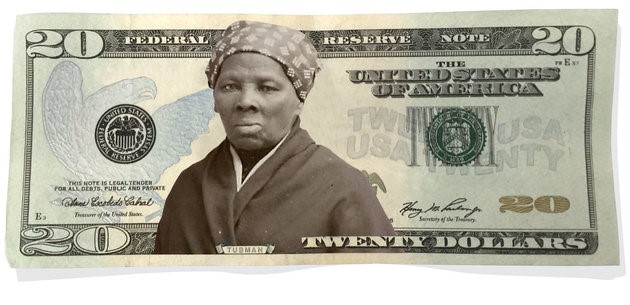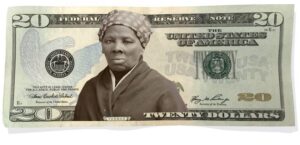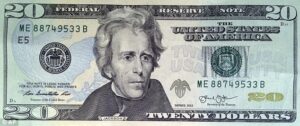
Harriet Tubman and Andrew Jackson: A Match Made in the U.S. Treasury Department
Note: This essay, with its cross-border themes, is being jointly posted by The Republic and Borealia: A Group Blog on Early Canadian History. Our thanks to Denis McKim for coordinating this joint post.
The net has been abuzz with news of Treasury Secretary Jack Lew’s announcement that Harriet Tubman will be placed on the front of the $20 bill and Andrew Jackson demoted to the back. The first African American to ever appear on an American bill, Tubman was a slave-turned-Underground Railroad operative, then an agent for the Union Army during the Civil War. Jackson was the first U.S. President to be born of common people, and he achieved legendary status as the Hero of New Orleans in the War of 1812. He was also an unrepentant slave holder and the architect of Indian removal.
Surely, the change to the $20 bill reflects some sort of shift in America’s cultural outlook. It has been sixty years since the Civil Rights Movement. Black Lives Matter is, perhaps, the next evolution of what African Americans fought for in the 1950s and ’60s. Tubman was a remarkable woman who fought against and overcame a system of bondage that nearly tore the nation in two. Yet she could not overcome the inherent racism that allowed that system to flourish and has remained to this very day. Tubman left the United States and lived in British Canada from 1851 to 1858, disgusted with the racial failings of America. Such contradictions raise the question of why Secretary Lew is placing her on the $20.
Jackson is equally puzzling. He actually hated paper money and surely rolled over in his grave when the Treasury Department placed him on the bill in 1928. Yet America at the time needed a guiding force that reflected democracy and the people. Jackson certainly fit the bill (pun intended). Few at the time were troubled about the rights of the enslaved or of Native Americans; Civil Rights was still decades away.
In twenty-first-century America, Tubman is a much more appealing figure than Jackson. Both, however, have their pluses and minuses when it comes to being a symbol for America important enough to place on the iconic $20 bill. This essay, collaborated on by a Tubman scholar and a Jackson scholar, seeks to explore some of these contradictions and the legacies of two Americans who were so different, yet are now joined and will soon be in the pockets of so many.
Tubman on the Front
The $20 bill is an unlikely place for Tubman, an American-Canadian transnational, militant direct-action abolitionist, who struggled with finances for the majority of her life. A devoted Christian, moreover, “money is the root of all evil” was quite frankly her perspective on cash. Chaining a liberator to a capitalist tool that oppresses and exploits a wealth of people is paradoxical. Deeming Tubman, as many assert, an “American Hero” is unbefitting as well and it is outright dismissive of British Canada. For some seven years, Tubman fled the United States, with others, for freedom. Settling in the borderland town of St. Catharines, Canada West, she was able to negotiate nations in the same manner as she navigated the American South and North. Tubman explained: “I wouldn’t trust Uncle Sam with my people no longer…I brought ‘em clear off to Canada.”[1] To Tubman and other freedom seekers, Canada was “the land of the free, and the home of the brave.” When Tubman decided to live in the “Sweet land of liberty” again, she settled in Auburn, New York, an ideal location on the edges of the “Burnt Over District.” While the American-Canadian border hardly played a daily role in Central New York, a hint of its presence always loomed and allowed reasonable access to Canada, in case of emergency. The mobile-minded Tubman utilized these means to reenter Canada on occasions, including in wake of the 1859 John Brown insurrection.[2]
This, of course, is not the story the federal government’s $20. They want to project a rigid nationalist message that Tubman was a Union Civil War spy and nurse, not that she was an unpaid veteran who had to petition repeatedly for compensation. In 1899, nearly eighty years old, she received $12 per month for her service as a nurse, and $8 as a widow’s pension for her deceased Union husband Nelson Davis, ironically totaling $20.[3] Neither is the new bill’s intent to divulge that Tubman was conned out of money by a fraud artist, worked as a domestic servant for the elite, borrowed funds from friends, and solicited donations or told Underground Railroad tales for her ever-present need for capital. Perhaps this is part of Tubman’s attraction; like America and the greater portion of its citizenry, she was a debtor. Tubman’s money issues were not all self-inflicted or because she was fiscally frivolous, but it is the systemic problem with capitalism. Harriet Tubman cared for the lowly, fed the sick, clothed the naked, and even built the Tubman Home for the Aged in Auburn. She looked after others, though her assets were meager. Money, the very thing that taunted and pained Tubman throughout her life, is now going to be tied to her very existence by the U.S. Treasury. Should this be rejoiced, ridiculed, or utterly rejected? In addition, while a score of African Americans are cheerful about Tubman on the $20, how does her gender factor in as she stands alone among men on dollars?
Jackson on the Back
 Andrew Jackson has always been controversial and perhaps this is the reason for his demotion to the back of the $20 bill. In one sense, it is absurd that Jackson is on paper money anyway. He hated a currency that he considered unstable, easily manipulated, and often worthless. In the early nineteenth century there was no “American” currency. That is, none printed by the government and recognized as the accepted medium of exchange. To be clear, Jackson did not hate all banks, as some today wrongly argue. He hated the monopoly and power of the Bank of the United States and the unstable nature of paper money. Why Jackson was initially placed on the $20 bill is something of a mystery. There was no discussion of the legislation when it was passed, but many historians surmise that coming at the tail end of the Progressive Era, when the government had been battling monopoly, trusts, and corruption, Jackson made a perfect candidate. He was the original defender of the people against big business. He famously explained: “The bank…is trying to kill me, but I will kill it.” Jackson’s bank veto was presented as a monumental defense of the people and denunciation of monopoly.
Andrew Jackson has always been controversial and perhaps this is the reason for his demotion to the back of the $20 bill. In one sense, it is absurd that Jackson is on paper money anyway. He hated a currency that he considered unstable, easily manipulated, and often worthless. In the early nineteenth century there was no “American” currency. That is, none printed by the government and recognized as the accepted medium of exchange. To be clear, Jackson did not hate all banks, as some today wrongly argue. He hated the monopoly and power of the Bank of the United States and the unstable nature of paper money. Why Jackson was initially placed on the $20 bill is something of a mystery. There was no discussion of the legislation when it was passed, but many historians surmise that coming at the tail end of the Progressive Era, when the government had been battling monopoly, trusts, and corruption, Jackson made a perfect candidate. He was the original defender of the people against big business. He famously explained: “The bank…is trying to kill me, but I will kill it.” Jackson’s bank veto was presented as a monumental defense of the people and denunciation of monopoly.
The sea change for Jackson on the $20 bill has actually been waged for years, one of the main rationales being he was a genocidal maniac who destroyed Native American cultures. Look at virtually any website or commentary on the currency issue, and you will see that this is a core complaint. Jackson also was a slaveholder. He was unrepentant, owned upwards of 150 human beings, and defended the South’s right to maintain an abhorrent institution. Certainly, there is no excuse in today’s time for the racial bigotry of Jackson. Yet to judge him with a 21st century moral absolutism is off the mark. And if Americans decide to deface Jackson for actions against Natives and Blacks, they might as well do the same for most of the Founding Fathers. Take down the Washington Monument, bulldoze Jefferson’s Monticello, remove Madison from all mention when it comes to creation of the Constitution. Repositioning Jackson to the back of the bill is telling and is better than entire removal. It reflects the changing social mores of our society, but not a complete erasure of our past. This is as it should be. Americans should not erase the people and history that they do not like. They can and should judge history and learn from it, but not seek to totally erase it. Perhaps the biggest question is why Tubman is being placed on the front. She represents the Civil War Era. The image most fitting to pair with Jackson is a Native American, the people to which he did so much harm.[4]
Conclusion
Since they are destined to be together on the $20 bill, it is best that Tubman and Jackson are back-to-back. They clearly did not see eye-to-eye on a number of issues, including their outlook on the British. While Jackson hated the British and fought the Redcoats in the American Revolution and during the War of 1812, at New Orleans, Tubman respected the British for abolishing slavery and fashioning Canada for fugitives. The sentiments each held for the British were lasting. Jackson’s elder brother Hugh died in battle during the American Revolution and when the teenage Andrew was held captive and refused to clean the boots of a British officer, the Redcoat swung his sword, cutting Jackson on the head and hand, leaving both physical and psychological scars. Jackson despised the English even in his presidency. Tubman also experienced a head wound as a youngster, but at the hands of an American slaveholder seeking to enlist her help in capturing human property. Tubman resisted, and the overseer threw a weight that struck her in the skull, precipitating epileptic seizures and a lifelong illness. However, she had a mind to employ Canada for safety and, later, after Queen Victoria read Tubman’s narrative and was “pleased with it,” she mailed her a silver medal, which memorialized Victoria’s Diamond Jubilee in 1897.[5] At Harriet Tubman’s 1913 funeral, the medal from the Queen was placed in her coffin, and an American flag was draped on her casket, suggesting dual national identities.
Yet the transnationalism of Tubman is not a convenient characteristic and is usually avoided when attempting to tell a nationalist American story. That is certainly what the $20 bill is attempting to do. Jackson’s story is equally difficult in the twenty-first century. His disposition towards Natives, Blacks, and even the British, captures an American spirit that most today do not want to acknowledge. Will keeping Jackson on the $20 and including Tubman force people to remember the past and learn from nineteenth-century injustices? To say the very least, the Tubman-Jackson mismatch is a strange coupling. It is certainly safe to say that it is not “a match made in heaven,” but rather in the U.S. Treasury.
Matthew Warshauer is professor of History at Central Connecticut State University and the author of two books on Jackson: Andrew Jackson and the Politics of Martial Law and Andrew Jackson in Context.
dann j. Broyld is professor of Public History at Central Connecticut State University who has worked as a consultant for the forthcoming Harriet Tubman Underground Railroad National Monument in Cambridge, Maryland, to be opened in March 2017. He is currently working on a manuscript with the University of Toronto Press.
[1] Sarah H. Bradford, Harriet Tubman, the Moses of Her People (Mineola, New York: Dover Publications, Inc.), 22. Reprinted from 1886.
[2] See dann j. Broyld. “Harriet Tubman: Transnationalism and the Land of a Queen in the Late Antebellum,” The Meridians: Feminism, Race, and Transnationalism special issue: “Harriet Tubman: A Legacy of Resistance.” Vol. 12, No. 2, (November 2014) pg. 78-98.
[3] Kate Clifford Larson, Bound for the Promised Land: Harriet Tubman, Portrait of An American Hero (New York, NY: Ballantine Books, 2004), 225-226, 252, 279.
[4] Matthew Warshauer, Andrew Jackson in Context (New York: Nova Science Publishers, 2009).
[5] Beverly Lowry, Harriet Tubman: Imagining a Life (New York, NY: Anchor Books, 2007), 373.
